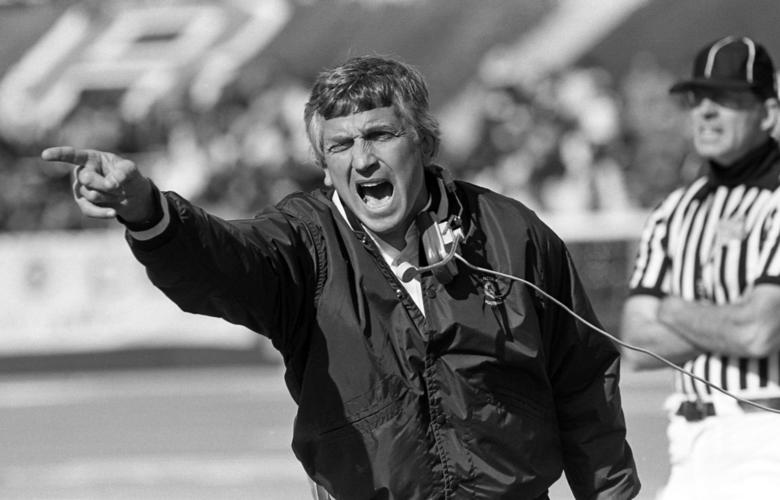My first meeting with a Hall of Fame college football coach came at the most unexpected place: Mrs. Brilliantine’s fifth grade class at the Hillcrest Elementary School.
Two of my classmates, twin sisters Terry and Sherry Ralston, were the daughters of Utah State football coach John Ralston. From 1960-62, Ralston coached USU to 9-2, 9-1-1 and 8-2 seasons, ranked No. 10 in the final 1961 AP poll, a never-to-be-matched golden era in my hometown.
In a small mountain town of about 20,000 people, you might imagine that John Ralston was bigger than life, and I’ll never forget the feeling of loss when Mrs. Brilliantine informed the class that Sherry and Terry would be moving to California.
“Their dad is leaving to become the new football coach at Stanford,” she said.
I was crushed. Why would someone leave Utah State for a place called Stanford? Where was it, anyway?
A week or so later, Coach Ralston himself walked into our classroom, probably to give his daughters a ride home from school. I summoned the courage to ask if he was truly leaving the Aggies.
“I am, son,” he said. “But you’ll have a fine coach to replace me.”
But you know what? There was no “fine coach” to replace John Ralston. By the time I was in college, Ralston had coached Stanford to back-to-back Rose Bowls, producing Heisman Trophy quarterback Jim Plunkett.
As he left Stanford to become head coach of the Denver Broncos in 1972, Ralston had a college coaching record of 86-47-4, a winning percentage of 64.2. That is a very important number. When he was nominated for induction into the College Football Hall of Fame in 1993, Ralston was an easy first-ballot selection.
The College Football Hall of Fame voting criteria says that to be considered for election, candidates “must have a .600 winning percentage.”
Ralston had wonderful timing. A year later, at 66, he came out of retirement and coached woeful San Jose State for four seasons. The Spartans went 11-34.
That dropped Ralston’s career winning percentage to 54 percent. Technically, he would no longer qualify to be on the Hall of Fame ballot but I doubt there is a person in college football who doubts Ralston is of genuine Hall of Fame timber.
I bring this to your attention because the National Football Foundation and College Hall of Fame Class of 2019 was announced Monday and once again it did not include Dick Tomey or Larry Smith.
That’s because Smith completed his coaching career with a .531 winning mark; Tomey is at .577. Decimal points continue to keep two worthy Hall of Fame coaches from induction.
Why? Because Smith began his head coaching career at downtrodden Tulane, where he went 2-9, 3-8 and 4-7, and later took on a massive rebuilding job at Missouri in which he opened 3-8, 3-8.
If you subtract those break-in years at Tulane and Missouri, Smith’s career winning percentage is elevated to exactly 60 percent. I have always felt that Smith’s work at Arizona alone is Hall of Fame-worthy. He was hired in April of 1980, inheriting an NCAA investigation from a previous regime that would put Arizona on a two-year probation and a ban from TV games.
He also inherited the rubble of a 20-year period in which Arizona was dominated by ASU, and yet went 5-0 against the Sun Devils to finish his UA days, twice knocking ASU out of the Rose Bowl. Somehow he won 63 percent of his Arizona games.
So many of the 217 coaches in the Hall of Fame did not follow the do-more-with-less path that Smith and Tomey pursued.
Tomey was hired to coach Hawaii in 1977, a time when the Rainbow Warriors weren’t even a Division I program. They had played Texas A&M-Kingsville, Kent State, Grambling State and Montana State a year before Tomey arrived.
Tomey coached Hawaii to a 63-46-3 record, stepping into full-scale Division I competition against, among others, Michigan, Wisconsin, Nebraska and Oklahoma.
And then Tomey went 95-64-4 at Arizona, a percentage that rounds up to 60.
But much like John Ralston, Tomey then accepted the task of reconstructing San Jose State’s long-broken program, coaching the Spartans to 9-4 record his second season. That was national coach-of-the-year quality. Yet Tomey went 25-35 at San Jose State and his Hall of Fame chances became infinitesimally small.
It’s not like the Hall of Fame hasn’t made exceptions.
Houston’s Bill Yeoman was inducted with a career percentage of .594. Navy’s George Welsh is in the Hall of Fame with a .588 ratio. Baylor’s Grant Teaff is in at .529, and even long-ago Oregon coach Len Casanova was elected with a .524 winning percentage.
Tomey says that former Indiana, Colorado, Northern Illinois and Miami of Ohio coach Bill Mallory, who has a .561 career percentage, is a no-brainer to the Hall of Fame. “Extenuating circumstances do not figure into what they are voting for,” Tomey says now. “An arbitrary number eliminates people like Mallory, whose absence from the Hall of Fame is the most egregious example. Bill’s not in just because he didn’t coach at Ohio State or Michigan.”
One problem is that Tomey and Smith don’t have a strong advocate, someone to persuade the Hall of Fame that the winning percentage qualifier is not a true indication of excellence. I mean, the great Hayden Fry of Iowa has a .564 career percentage and is in the Hall of Fame.
It’s a delicate issue. Smith died 10 years ago. Mallory died last year. Tomey is 80. All were the embodiments of a Hall of Fame coach: They treated their players with respect, represented their schools and families with dignity, didn’t break rules and won almost 60 percent of their games in some of the most difficult circumstances in college football.
The Hall of Fame is incomplete without them.





